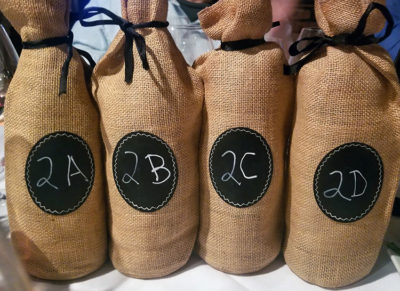1989 Barolo — A Promise Delivered
Looking back over the last 14 years of collecting and tasting Barolo, there has been no other vintage which has provided me more intellectual stimulation, anticipation and sheer pleasure as 1989. I still look back upon my first experience and how naive I was, having been invited to an ‘89 Barolo and Barbaresco dinner by a good and generous friend, who provided all of the wines. I remember the talk around the table as the other attendees spoke in depth about their expectations for the ‘89s. I, however, was very new to collecting and didn’t understand how the finicky Nebbiolo grape would mature over time. Sadly, this tasting left me confused about A Realization Of How Barolo & Barbaresco Matures That was over twelve years ago, and the experience helped develop the foundations of what I came to understand over time about how Barolo and Barbaresco matured, the differences between vintages then and now, and–of course–the patience required to be a collector. For so many years, I placed these wines away in my cellar, going on the promise that they would one day mature into something special. Granted, I had vintages like ‘82, ‘85, ‘88, ‘90, and ‘95 to show me that the wines could mature into something special. However, the cool vintages, often referred to as classic, simply sat in my cellar and gathered dust. ‘89, ‘96, ‘99, and ‘01 were all years that I was instructed to buy and put away for the long haul. I have to admit that there were a few times that I became afraid that I would never see some of these vintages deliver the promise I was guaranteed, and 1989 was one of them. Tasting after tasting, they simply never seemed to want to come around–until just recently. Finally, in 2015, my group conducted a vertical tasting of 1989 Barolo and Barbaresco, and for the very first time, the wines showed me just how amazing the vintage really was. It was as if the vault of tannin had suddenly opened up, allowing the textures of each wine to flesh out across the palate, and deliver the depths of fruit and fine details to satiate the senses. The only sad thing about this tasting was when I looked at the market in hopes of securing some of my favorite wines, and I realized that the market had pushed pricing through the roof. Since that time, each taste of a 1989 has been a gift.
It was with this in mind that the planning of our most recent 1989 Barolo and Barbaresco tasting, a 30-year retrospective, created a stir in me that was indescribable. The excitement, anticipation, and importance of the event, in my opinion, was unparalleled.
However, when speaking about 1989, we’re talking about a time when great vintages only came along once in a decade, and it was the result of what We can all see it so much clearer now as the wines have opened up. Their fruit is often dark, almost imposing, layered with dried florals and savory, more than sweet, spices. On the palate, their textures soothe with a balanced of silk, weight and structure, still slightly tannic but also cool-toned and lifted by acids and minerals. The best of them will continue to mature for many more decades, promised by the lingering structure on the finish. Even better is that Barbaresco seems to have performed just as well. The fact is that 1989 may be the greatest vintage of Barolo in the last 40 years or more. The only problem today is finding and affording them. On to the Tasting Notes (Tasted single-blind knowing only the wines in each flight, but not their order.) Flight 1: Barbaresco The Barbaresco flight was a great way to start, showing jus thow well both regions did in 1989, as well as just how easily Barbaresco can hold up against Barolo in Produttori del Barbaresco Barbaresco Riserva Rabajà 1989 – Not the start to our ‘89 Barolo and Barbaresco vertical that we were hoping for; unfortunately the ‘89 Rabaja has seen better days, and as much as I’d like to hope it was just the bottle, the only thing that seemed to really be wrong was that the wine was on the decline. Here I found a display of dark moist soil tones, animal muskiness, minerals, and black cherry with a hint of decay. On the palate, soft textures gave way to black cherry fruits and earthy minerals, as an odd herbal tone developed, along with hints of old barrel. The finish was long with staining red fruit, rusty minerality and earth. (87 points) Prunotto Barbaresco 1989 – The ‘89 Prunotto Barbaresco was a wonderful surprise when these blind wines were unveiled. The nose showed dusty, dark red fruits, sweet mineral tones, cherry, dried florals and hints of undergrowth. On the palate, I found silky textures, brought to life through vibrant acidity, as pretty, ripe cherry flooded the senses, along with minerals and earth tones. The finish was long, resonating on dark red fruits, with tannins that still showed a bit of youth. It’s amazing to think, but this Barbaresco still has some years of maturation ahead Produttori del Barbaresco Barbaresco Riserva Pajé 1989 – The ‘89 Paje was the wine of our Barbaresco flight for me, showing spicy dark red fruits with lifting minerality, fresh soil tones, and dried roses. On the palate, I found soft textures, contrasted by slaine-minerality and stunning, juicy acidity, as fresh dark red fruits and savory spices gilded across the senses. The finish was long and remarkably pretty, resonating on dark red fruits with amassing inner florals and lingering mineral tones. It was simply so balanced, vibrant and in no sign of declining at any time in the near future. (95 points)
Flight 2: La Morra & Barolo Grouping La Morra and Barolo together was done out of necessity, as the opportunity to taste three expressions of Cannubi was hard to pass up. What’s more, three unique expressions. In the end, I was a much bigger fan of the Sandrone than most others at the table, which was largely the result of its perfect balance in spite of its modern leanings. The Francesco Rinaldi was classic in every way, and the Paolo Scavino excelled at showing a mix of the house style together with those textbook, mineral-infused Cannubi tannins. As for the Ceretto, it seemed to have seen better days. Luciano Sandrone Barolo Cannubi Boschis 1989 – The ‘89 Sandrone Cannubi Boschis was a dramatic, obviously modern, yet also wonderfully balanced wine. The bouquet was a mix of black cherry, sweet herbs, and hints of brown sugar, offset by animal musk and lifting minerality. On the palate, I found velvety textures contrasting zesty acids and spice, as fine tannins settled in, and a mix of tart cherry, minerals, and spiced orange soaked the senses. The finish was long, yet vibrant, showing a structure that was still youthful, aided by mouth watering acidity, and lingering spiced cherry. There’s no rush here, and although it is decidedly modern, I liked it quite a bit. (95 points) Francesco Rinaldi e Figli Barolo Cannubbio 1989 – On the nose, I found a dark and moody expression at first, opening with undergrowth and sous bois, yet opening to reveal sweet and savory herbs, dried cherries and hints of smoke. On the palate, soft, enveloping textures flooded the senses with notions of black cherry as a balanced mix of fine tannin, earthy minerals and brisk acidity added liveliness. The finish was long, resonating on acid-kissed tart red fruits and minerals. A classic expression, with a rustic edge, and an amazing value in its day. (94 points) Paolo Scavino Barolo Cannubi 1989 – The nose was dark and intense, but in the best possible way, as the ‘89 Cannubi burst from the glass with an array of Azienda Bricco Rocche (Ceretto) Barolo Brunate 1989 – The bouquet was showing its maturity, with dusty spices, minerals and dried florals giving way to overripe crushed strawberry. On the palate, silky textures offset by zesty spices paved the way for mineral-infused dried cherries and earth tones in a slightly murky expression. The finish was long, resonating on earth tones and ripe red fruits as tannins slowly saturated the senses. The Ceretto Brunate seems to have seen its best days, yet there’s still life in it for as long as its fruit can maintain balance against its unresolved tannin core. (90 points)
Flight 3: Castiglione Falletto I’ve heard many times that Castiglione is capable of creating the most balanced wines of all of the Barolo villages. This theory is based on the meeting of two very Azienda Bricco Rocche (Ceretto) Barolo Bricco Rocche 1989 – The nose was dark and moody at first, lifted over time by dusty minerality, as black cherry, savory spice and hints of smoke developed in the glass. On the palate, I found silky, deep textures, contrasted by a buzz of intense acidity, which for a moment seemed like too much, but was then balanced by notes of dried black cherry, minerals and slow-mounting tannins. The finish was long and structured, as the cheeks puckered from lingering acids, red fruits and inner florals resonated throughout. (92 points) Bruno Giacosa Barolo Villero di Castiglione Falletto 1989 – The greatest thing about blind tasting is when you come to a bottle that simply shows its pedigree
Vietti Barolo Rocche 1989 – To this day, the 1989 Vietti Rocche is, in my opinion, one of the greatest examples of this wine and vineyard ever created. Here I found a mix of mineral-drenched dried cherries and plum, with dusty florals, crushed stone, forest floor, hints of smoked meat and cedar. On the palate, silky, enveloping textures gave way to a pure expression of forest berries, minerals, rosey inner florals, tart acids and hints of lingering fine tannin. The finish was long, with tannins still resonating amidst notes of dried cherry, earth tones and roses. What an amazing bottle of Barolo. (97 points)
Flight 4: Serralunga d’Alba The entire flight from Serralunga showed that this village was blessed in the 1989 vintage. The terroir, power and textbook dark minerality came through in each Bruno Giacosa Barolo Riserva Falletto di Serralunga d’Alba 1989 – The nose was gorgeous from the moment I tipped the glass, displaying citrus-tinged black cherry, sweet florals, dusty earth, dried roses and a hint of mint leaf. On the palate, I found silky, almost creamy textures giving way to ripe red fruits and spice with offsetting savory herbal tones and a coating of minerality. The finish was long with hints of balsamic spice, black cherry and hints of round tannin. What an elegant beauty of a wine. (95 points) Massolino Barolo Riserva Margheria 1989 – It’s amazing how you can still be surprised after fourteen years of collecting and focusing on Barolo, but that’s exactly what the ‘89 Margheria did, a wine that I didn’t even know existed. Here I found a dark and mineral-driven display with dusty red florals, dried black cherry, smoke and earth tones. On the palate, a soft and feminine expression gave way to zesty bright cherry, savory spice ands hints of cedar. The finish was long, filled Azienda Bricco Rocche (Ceretto) Barolo Prapò 1989 – The nose was earthy and a bit tired, showing a mix of balsamic spices, with dried cherries and dusty rose. On the palate, I found silky, enveloping textures, as zesty spice orange, bright cherry and minerals provided a lifted and vibrant display. The finish was long, as tannins came forward, drying its remaining fruit and leaving a mix of minerals and dried cherries to linger on. (91 points) Gaja Langhe Nebbiolo Sperss 1989 – Here I found a moody and dark bouquet, with a mix of red and black fruits, sweet herbs, spice and a hint of mint leaf. On the palate, silky textures were energized by a mix of zesty spiced blackberries, brisk acids and minerals as hints of tobacco and sweet herbs amassed toward the finale. The finish was long, as saturating tannins took control, resonating on dried black fruits and hints of savory herbs. It’s dark and intense with a lot of Serralunga character under the hood, but the paint job is 100% Gaja. (91 points) Credits and Resources Article, Tasting Notes and Photos by Eric Guido A special thanks to The Fine Wine Geek for organizing flights and his great generosity. A Special thanks to Brad Bonnewell for glassware and Chef Enrico Florio for personally preparing our meal at Buona Notte. View the Piedmont Collection at Morrell Wine and Spirits |

.jpg)
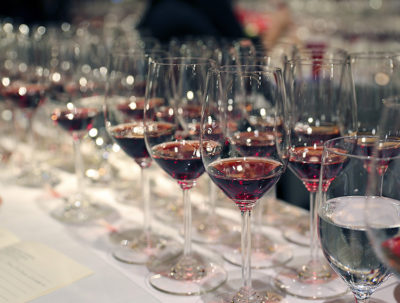 what the other participants were so excited about. The wines showed hard tannins, thin textures and often seemed overly acidic. They gave very little on the palate, and although each of them was quite pretty aromatically, each sip would leave me scratching my head, as their gripping tannins lingered on the senses. You could even say that it was a painful experience.
what the other participants were so excited about. The wines showed hard tannins, thin textures and often seemed overly acidic. They gave very little on the palate, and although each of them was quite pretty aromatically, each sip would leave me scratching my head, as their gripping tannins lingered on the senses. You could even say that it was a painful experience.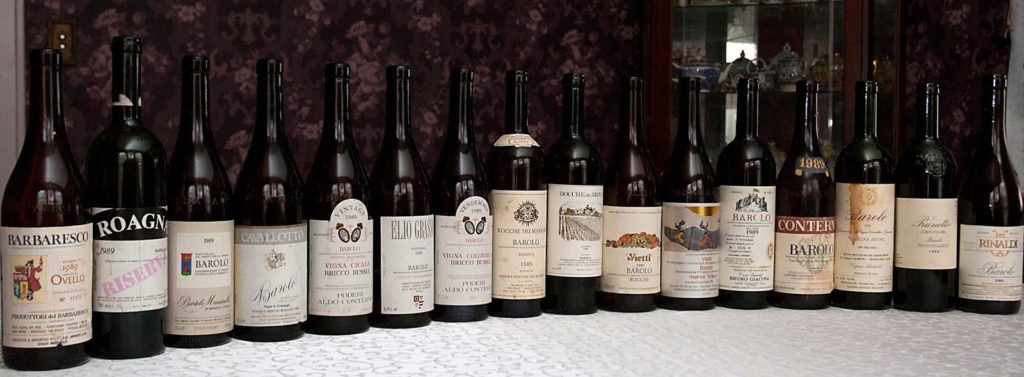
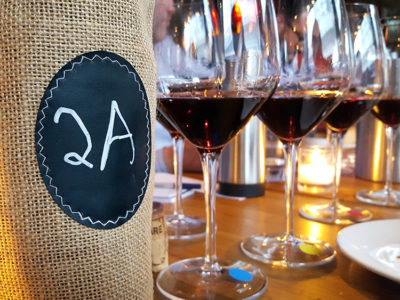 So much has changed throughout Barolo and Barbaresco since 1989, and in nearly all cases it’s for the better. However, one can’t help but wonder if today’s modern vintages will ever compare to these structured monolithic wines that have only recently revealed their charms. For one thing, farming practices have changed drastically, as the experimentation of the modernists resulted in a number of successful techniques that are used across the region today. Most important of all is the idea of keeping an open mind. You can see this now with even the most traditional producers; Giuseppe Rinaldi comes to mind. These changes, together with global warming and cleaner cellars, have created strings of vintages considered very good-to-great. In fact, in Piedmont today, vintages that would have been written off thirty years ago are now accepted as good years.
So much has changed throughout Barolo and Barbaresco since 1989, and in nearly all cases it’s for the better. However, one can’t help but wonder if today’s modern vintages will ever compare to these structured monolithic wines that have only recently revealed their charms. For one thing, farming practices have changed drastically, as the experimentation of the modernists resulted in a number of successful techniques that are used across the region today. Most important of all is the idea of keeping an open mind. You can see this now with even the most traditional producers; Giuseppe Rinaldi comes to mind. These changes, together with global warming and cleaner cellars, have created strings of vintages considered very good-to-great. In fact, in Piedmont today, vintages that would have been written off thirty years ago are now accepted as good years.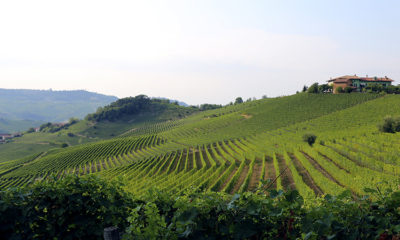 Mother Nature gave them. At a glance, 1989 started with a wet, cool spring resulting in irregular flowering, which initiated a short crop. What’s more, severe hail in June left its mark on many vineyards, further reducing yields. The summer was warm, but not hot, and temperatures dropped near the end of the growing season with wide fluctuations between day and night. The result was a small, late harvest with perfectly ripe grapes.
Mother Nature gave them. At a glance, 1989 started with a wet, cool spring resulting in irregular flowering, which initiated a short crop. What’s more, severe hail in June left its mark on many vineyards, further reducing yields. The summer was warm, but not hot, and temperatures dropped near the end of the growing season with wide fluctuations between day and night. The result was a small, late harvest with perfectly ripe grapes.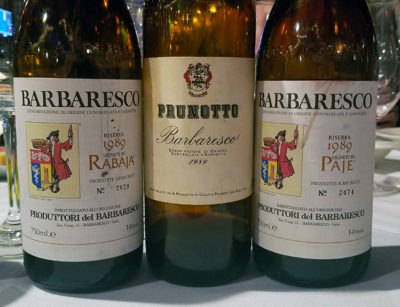 a good vintage. The Rabaja was disappointing, and the hope is that this was a bad bottle, but the following two were simply spell-binding examples of the region.
a good vintage. The Rabaja was disappointing, and the hope is that this was a bad bottle, but the following two were simply spell-binding examples of the region.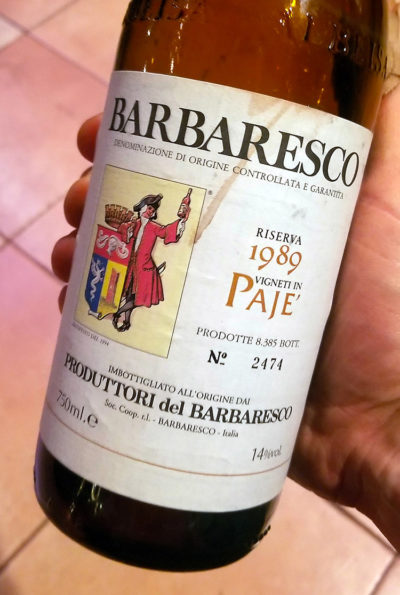 of it. Beautiful. (94 points)
of it. Beautiful. (94 points)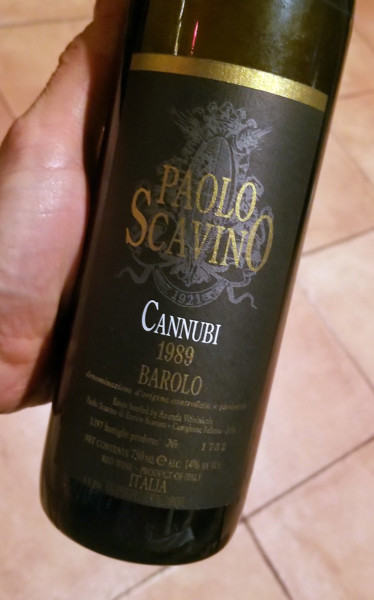 dark, mineral-drenched red fruits, savory spices, dusty dried herbs and crushed stone. On the palate, silky textures gave way to a twang of tart cherry, with savory herbs, exotic brown spices and lingering tannin that had a tactile, almost gritty feel. The finish was long, long ,long with remnants of youthful tannin lingering amidst zesty, cheek-puckering acids, tart cherry and classic, dark Cannubi minerality. (94 points)
dark, mineral-drenched red fruits, savory spices, dusty dried herbs and crushed stone. On the palate, silky textures gave way to a twang of tart cherry, with savory herbs, exotic brown spices and lingering tannin that had a tactile, almost gritty feel. The finish was long, long ,long with remnants of youthful tannin lingering amidst zesty, cheek-puckering acids, tart cherry and classic, dark Cannubi minerality. (94 points)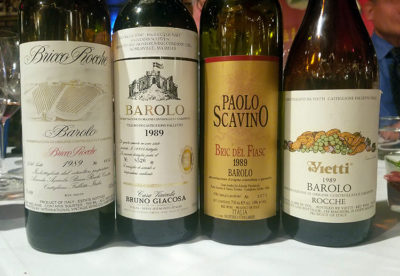 different soils types that come together to create a better balance. The clay-heavy, low calcium carbonate soils of La Morra, which help to give those wines elegance and rounder fruit, meet the sandy, high calcium carbonate soils of Serralunga and Monforte, which add power, longevity and minerality. Flight three was an excellent example of this, showing the nobility of the terroir, wines and vintage. What’s more, the ‘89 Vietti Rocche continues to be one of the highlights of this great vintage.
different soils types that come together to create a better balance. The clay-heavy, low calcium carbonate soils of La Morra, which help to give those wines elegance and rounder fruit, meet the sandy, high calcium carbonate soils of Serralunga and Monforte, which add power, longevity and minerality. Flight three was an excellent example of this, showing the nobility of the terroir, wines and vintage. What’s more, the ‘89 Vietti Rocche continues to be one of the highlights of this great vintage.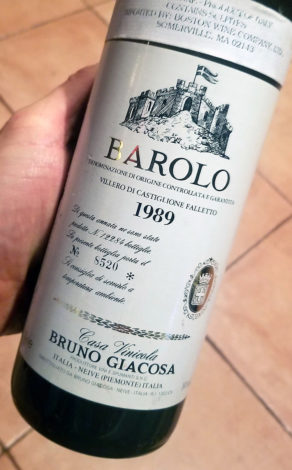 without needing its label; the ‘89 Giacosa Villero was one of those experiences. Here I found ripe black cherry intertwined with sweet herbs, dusty dried roses, exotic spice and hints of undergrowth. On the palate, the Villero was wonderfully textural, as velvety waves washed across the senses, delivering a twang of acid-tinged black cherry, sweet spice, minerals and a hint of tannin. The finish was long and balanced, still showing a youthful structure, but with fleshy red fruits, minerals and spice to satisfy the senses. A gorgeous bottle of Barolo. (96 points)
without needing its label; the ‘89 Giacosa Villero was one of those experiences. Here I found ripe black cherry intertwined with sweet herbs, dusty dried roses, exotic spice and hints of undergrowth. On the palate, the Villero was wonderfully textural, as velvety waves washed across the senses, delivering a twang of acid-tinged black cherry, sweet spice, minerals and a hint of tannin. The finish was long and balanced, still showing a youthful structure, but with fleshy red fruits, minerals and spice to satisfy the senses. A gorgeous bottle of Barolo. (96 points)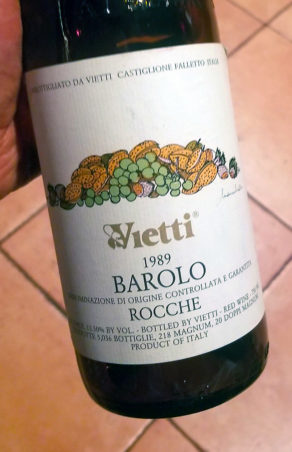 Paolo Scavino Barolo Bric dël Fiasc 1989 – The nose was deeply layered, showing brown sugar and exotic spices, with dark herbal tones, moist soil, black cherry, mulling spice, and dried florals. On the palate, I found soft textures, losing a little momentum through the middle, but then finishing strong, as zesty acids added life to notes of black cherry, sweet herbs and dark chocolate. The finish was medium in length, with a mix of acid, earthy minerals and dried red fruits saturating the senses. Has the ‘89 Bric del Fiasc seen its best days? I doubt it, but this bottle didn’t show as well as expected. (92 points)
Paolo Scavino Barolo Bric dël Fiasc 1989 – The nose was deeply layered, showing brown sugar and exotic spices, with dark herbal tones, moist soil, black cherry, mulling spice, and dried florals. On the palate, I found soft textures, losing a little momentum through the middle, but then finishing strong, as zesty acids added life to notes of black cherry, sweet herbs and dark chocolate. The finish was medium in length, with a mix of acid, earthy minerals and dried red fruits saturating the senses. Has the ‘89 Bric del Fiasc seen its best days? I doubt it, but this bottle didn’t show as well as expected. (92 points)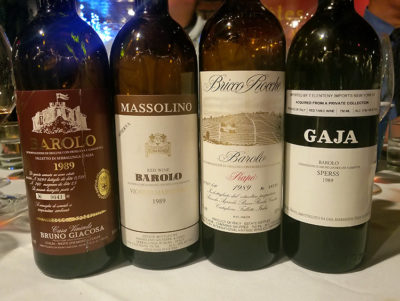 wine, and I really felt that we saved the best for last. As for the Gaja, and a score that some may feel is low, much of that had to do with the effect of its oak aging, and how it masked the delicacies of its Nebbiolo fruit. However, I’d be happy to have any of these wines in my cellar.
wine, and I really felt that we saved the best for last. As for the Gaja, and a score that some may feel is low, much of that had to do with the effect of its oak aging, and how it masked the delicacies of its Nebbiolo fruit. However, I’d be happy to have any of these wines in my cellar. with minerals and zesty acids, as tart berries and inner floral tones resonated throughout. (94 points)
with minerals and zesty acids, as tart berries and inner floral tones resonated throughout. (94 points)